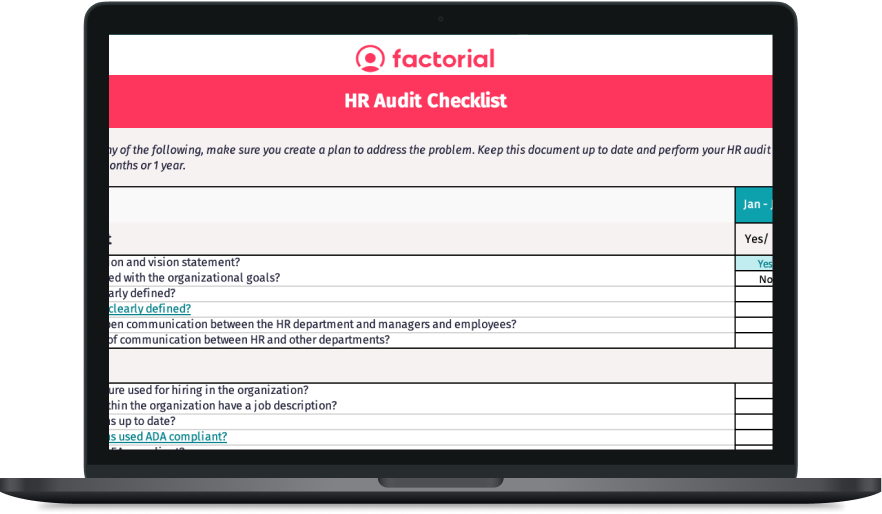Organizations should be constantly evolving. Unfortunately, outdated policies and procedures can stick around way too long.
In order to avoid legal issues and ensure that your company complies with the labor and employment laws, it is important to perform a regular internal HR audit. While this may sound like a daunting task, remember that auditing is a valuable tool that will help facilitate your business’s development.
In this post, we’ll show you how to effectively use an HR audit checklist. But first, let’s gain a better understanding of what this assessment entails and how to conduct a human resources audit.
Related: Watch this quick video that explains everything you need to know about HR audit checklists 👇
What is an HR audit?
The definition of an HR audit is a thorough review of the policies, procedures, documents, and systems in Human Resources. HR professionals conducting an audit systematically review every facet of their work and contribution to the company.
This is an opportunity to identify which practices are working and which are not. This is a vital step when it comes to improving operations and performance. Usually, HR professionals will carry out the audit. However, companies can also choose to hire an external company to conduct a human resources evaluation.
Considering the time and effort that you need to invest in a full-scale assessment, it is advisable to perform an audit once a year.
The completion of one HR audit checklist yearly should be enough for your company to obtain all the HR-related data it needs. When you make an assessment, you can choose to focus on the following areas:
- Recruitment
- Onboarding
- Management
- Training and Development
- Employee Relations
- Performance
- Strategic Planning
- Documentation
- Best Practices
- Compliance with Laws and Regulations
4 Types of HR Audits
There are four main types of human resources audits that are most commonly conducted. All of the following audit types involve systematically reviewing the human resources functions within the company.
- Comparative Approach Audit (Internal): This approach compares the performance of two different human resources management departments. If your department is new the HR audit, mirroring the successful plan of action of another company is often a good place to start.
- Expert Audit (External): In this case, the audit is carried out by an individual or company outside of the organization. This approach can be useful if your department lacks the time or resources to conduct your own audit. Consultants specialized in conducting human resources audits can provide a valuable perspective on your management processes. Unfortunately, such services are often quite pricey.
- Statistical Approach Audit: In this HR audit, HR departments leverage data within the company in order to assess overall performance. It may be useful to look at information about absenteeism or turnover rates.
- Management by Objectives Audit: This type of audit assesses whether your HR department was able to achieve the objectives it previously set. If you wish to implement this kind of audit, make sure to read up on setting and reaching OKRs.
Regardless of the type of HR audit that is happening, it is vital for every business to prepare in order to prevent hefty fees and penalties. That’s why it’s beneficial to utilize a human resources audit checklist to ensure you and your team don’t miss anything.
Benefits of Conducting an HR Audit
There are many advantages to conducting an HR audit. Without a doubt, the most valued is that it provides you with a broad vision of the inner workings of your company. The audit often reveals how the human resources department fulfills its daily functions.
An audit is a comprehensive tool used to analyze multiple aspects of a company. Conducting an audit is essential to a company’s growth and improvement.
Knowing the inner workings of your organization, allows your company to detect potential complications and/or areas of improvement. Also, as a result of conducting an audit, you can see where the HR team is already doing a great job. Highlighting these wins can be great for morale.
Still on the fence? Here are the key advantages of performing an HR audit.
- Provides a detailed vision of the human resources department
Understanding how each area of the department works, and how they integrate into the company, is essential to moving forward with the company’s objectives.
- Encourages compliance
It is in a company’s best interest to ensure compliance with ever-changing rules that are present within the industry. For example, a human resources audit helps to encourage compliance with the labor standards act, among others.
- Promotes positive change
Evolving is crucial and identifying a company’s weaknesses/possible pain points, enables them to better form a plan of action and implement it to improve.
- Provides valuable data
If you are a regular reader of the blog, you know that we love speaking about the collection of reliable data. Why? This data allows a company to quantify aspects of their HR department that may have previously been neglected. With an audit, you can retrieve valuable data that, after proper analysis, will help guide you to make the correct decisions later on.
How does an HR Audit work?
If you are thinking about conducting an audit of your company, you may be feeling a bit stressed. Are you wondering where to start, which steps to take, and who will be the one performing the audit?
Although there are many different ways in which companies can utilize HR audits, most assessments follow the same structure. The HR audit consists of three parts.
Pre-Audit
The first step is the pre-audit. During this phase, you will need to determine what data would be most useful to collect. Start by defining which HR function or processes you would like to evaluate under the audit.
For example, you may want to review your HRIS, the policies of the HR department, or performance evaluations. If there is an area in your company that requires improvement, you should consider adding it in the audit as well.
Our advice is to let HR metrics drive these decisions. If you are keeping track of KPIs such as time-to-hire and retention rate, you’ll probably have a pretty good idea of where your HR department is falling short.
As soon as you have identified areas for improvement, you can continue to the next steps of the HR audit process:
- Decide whether the audit will be conducted internally or externally.
- Define the audit type you want to carry out.
- Establish clear and defined objectives to result from the audit.
- Create a plan of action to arrive at your objectives.
Analysis of the data
The next step is the analysis of the data. In this step, you will assess the processes, procedures, policies, documents, and data that you decided to audit in the previous step. Collect the information in an organized fashion so that you can draw conclusions.
Prepare a report with your audit results
The final step is to draft a report that contains your findings and recommendations which will aid and help the Human Resources team succeed.
What is an HR Audit Checklist?
An HR audit checklist provides a roadmap of your audit. It shows what essential functions you absolutely must review. Sometimes this is not as intuitive as you would expect. We may be so accustomed to our old, tired processes that it doesn’t occur to us that there’s a better way to do things.
An audit is a key moment for the department and the company as a whole, so they can learn and keep moving forward as an HR professional. Using a checklist for HR audit processes ensures you don’t miss anything.
Why Use an HR Audit Template?
Whether the focus lies on policies or performance, a yearly review of your HR uncovers problems and challenges that exist within the department. Evaluating these issues allows your company to improve and prevents negligence or complacency.
Furthermore, using an HR audit checklist helps guarantee that your company is in accordance with current HR and employment laws. It provides managers with a clear vision of what’s happening in the company, enabling them to determine best practices and discover opportunities for growth and development.
An effective HR audit will also have a positive effect on employees. It increases transparency, which has been shown to boost employee morale, and shows that the company is committed to constant improvement. These positive changes lead to increased productivity and employee satisfaction.
Download Free HR Audit Checklist Template
Before starting the assessment, it is important to have an HR internal audit checklist to stay organized and efficient throughout the HR audit process. This list contains detailed questions that apply to the different areas of Human Resources and is typically a couple of pages long.
Need a little extra help managing your audits this year? Not to worry, we’ve got you covered. Here’s our comprehensive HR audit checklist template excel to help you get the most out of your HR department. This HR audit template will make sure you’re on top of everything going on in your company.
Want to make sure your organization’s records are always up-to-date, compliant, and effective? We’ve got a fully digital and centralized solution for you! Factorial’s all-in-one business management software has everything you need to manage your team. Try it today with a 7-day free trial.
HR Audit FAQs
How to prepare for an HR audit?
When it comes to HR audits, you should take a proactive approach rather than a reactive one. It’s best to prepare strategically and follow these key steps:
- Review HR policies and procedures: Make sure all company documents and processes are up to date. Including, employee handbooks, compliance documents, and more.
-
Assess compliance: Ensure your company is adhering to national and local labor laws, tax regulations, and other company policies.
- Gather data: Review your core HR metrics such as turnover rates, absenteeism, and performance to gauge how effective your HR efforts are.
-
Transparency: Inform your team about relevant details to the audit, timeline, their roles, and expectations.
What are the three levels of HR audit?
The three levels of HR audit are compliance, benchmarking, and strategic. They all assess a different aspect of HR to ensure HR teams are complying with employment laws and they are positively impacting the company.
Is HR audit mandatory?
While HR audits are not legally mandatory, they are highly recommended to ensure compliance, minimize risks, and improve HR effectiveness. Certain industries or companies under regulatory scrutiny may require audits more frequently.
Who conducts an HR audit?
HR audits can be conducted both internally and externally. Factors like the type of audit, situation, and other aspects will determine if the audit will be conducted by an internal or external member.



Thanks for the help
For my knowledge
Glad you enjoyed it!
This is an eye opener for HR professionals. Thank you very much